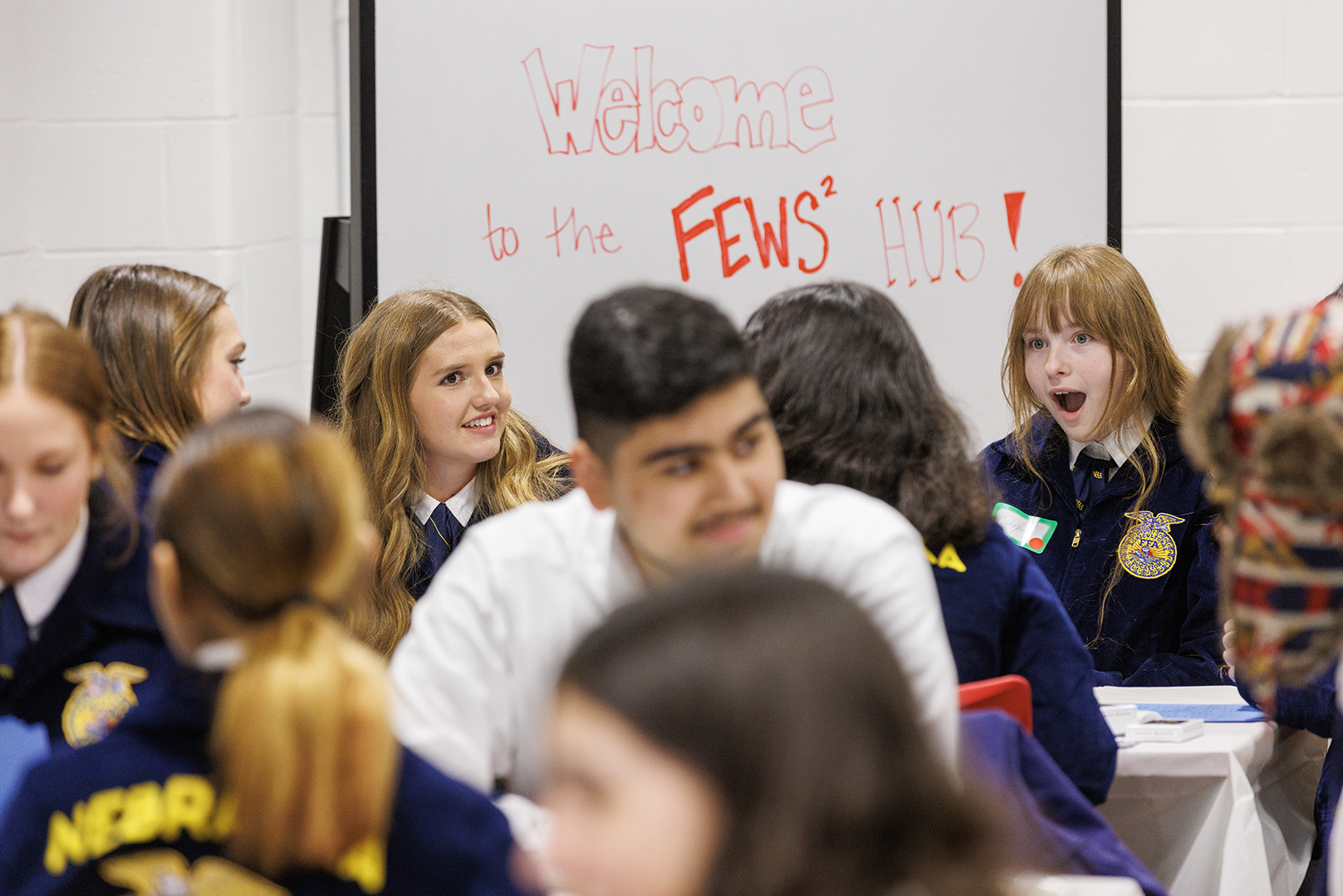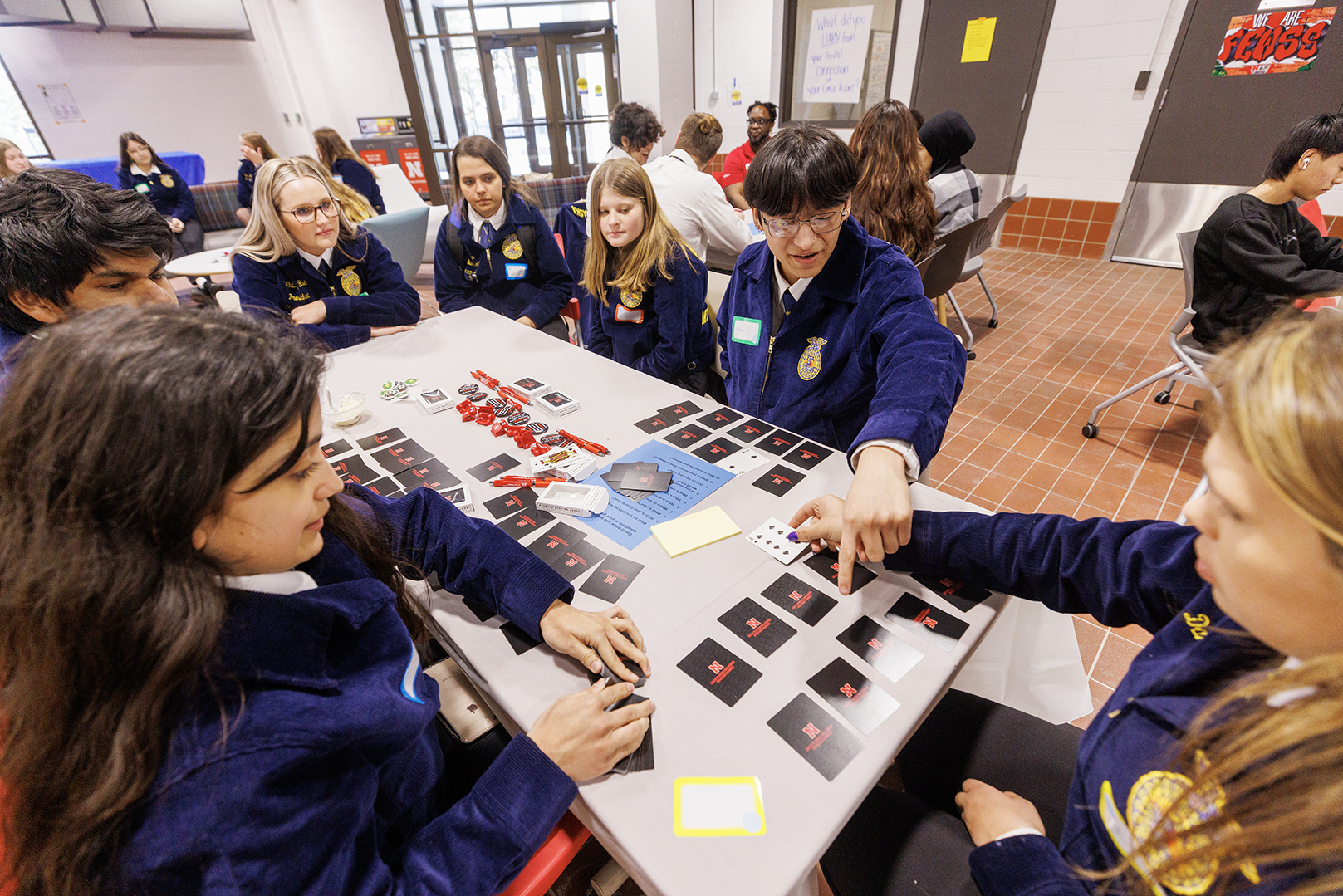
Whether worn in the country or city, the iconic blue and gold jackets of FFA chapters stand out — a symbol of a Nebraska-wide institution that impacts rural and urban areas.
Nebraska FFA members have been discussing that subject this school year through a Pen Pal letter exchange between rural and Omaha members. The process has helped the teens gain a better understanding of the state and its range of experiences.
Many of the Pen Pals met face to face recently on the University of Nebraska–Lincoln’s East Campus as part of the 2023 Nebraska FFA State Convention. Stacie Turnbull, state director of agricultural education with the Nebraska Department of Education, has been a key leader in coordinating the Pen Pal project with FFA chapters.
The project has provided “a great networking opportunity to see how other students around the state view agriculture and how they do different things in their ag classrooms and FFA chapters,” said Katelyn Shimic, a junior at Gering High School. “It’s a cool opportunity to learn from their experiences and how they benefit from ours.”
At one of the tables in a new collaboration space on East Campus, FFA members Erika Munguia and Carolina Thompson from Omaha Bryan High School and Megan Kindschuh and Lexie Eckhoff from Axtell High School chatted after weeks of exchanging letters.
The central benefit of the letter exchange has been “seeing the big differences between the urban agriculture versus the rural agriculture that we see back in our small town,” Kindschuh said.
Munguia lived in Lexington before moving to Omaha, so she has experience in rural and urban settings.
Omaha “is such a different environment,” she said. “You don’t have a cornfield right across the street, or cows or anything like that. So, it was nice to be able to write to people who do have these experiences and who don’t live in these really busy areas. We could see how their experiences differed from mine, and what they get to do versus what I get to do and how we both are learning typically the same things but in different ways. It’s just cool to see.”

Encouraging these low-key, friendly conversations among rural and urban FFA members has great value, said Allison Claussen, ag educator and FFA adviser with Pender Public Schools.
“It’s a casual conversation you might not be able to have without this program,” she said.
The Omaha Bryan FFA chapter got the ball rolling on the Pen Pal project after the chapter’s members saw during last year’s convention how greatly their experiences in Omaha can differ from those in the state’s rural communities.
The Omaha Bryan chapter is one of the state’s largest. Since its creation in 2012, it’s gone from 60 members to about 200, said Taylor Wilton-Cooper, the school’s FFA co-adviser and instructor in urban agriculture, food and natural resources curriculum.
Omaha Bryan’s Urban Ag Academy has a range of activities to help FFA members learn about the variety of Nebraska agriculture. The students have had visits from representatives of the Nebraska Wheat Board, Nebraska Pork Producers and Midwest Dairy. Students have learned about food science and visited City Sprouts, a community garden.
It may seem odd that Omaha Public Schools would have started an Urban Ag Academy at Omaha Bryan, but the creation of the program connects directly to key points that often arise in discussion of present-day agriculture. First, it benefits Nebraska and society as a whole when urban residents understand where food comes from. Second, modern agriculture needs a strong workforce pipeline that includes urban residents. The U.S. ag sector each year has about 141,800 job openings, but economists estimate that about 40% of those jobs go unfilled.
Filling job openings is important for direct farmland production but also for the wide range of additional career opportunities in modern agriculture. The Department of Agricultural Leadership, Education and Communication at Nebraska lists more than 300 such career options for students. Examples include food-science laboratory technician, agricultural equipment technician, water quality engineer, ag teacher, forester, ag economist, communications specialist and wholesale sales representative.
The Pen Pal project helps Omaha students see the notable variation in the state’s agriculture. Corn and soybean tower as key crops, it’s true, but that isn’t the whole story. Ag teacher Carrie Johns, whose FFA students at Gering High School participated in the Pen Pal project, noted that “our Panhandle gets lumped in with the rest of central and eastern Nebraska, as they think we’re all corn, soybeans, cattle.” But, she said, “out here we’re very diverse — potatoes, sunflowers, alfalfa, wheat, sugar beets, dry edible beans. We actually have a couple farmers growing mint. We have quite the variety of crops.”
That’s not all: “We irrigate differently, as well. We do have pivot irrigation, but we also have canal irrigation.”
Jacie Bonneau, a senior at Pender High School who participated in the Pen Pal project, said the letter exchanges help by enabling rural FFA members to explain that rural life is much more than stereotypes.
“We see people that aren’t from rural Nebraska sometimes stereotyping agriculture about what they think it is, but it’s a lot more,” she said. “It’s not just the animals or the crops. There’s more to it. Doing that Pen Pal really helps, so people don’t stereotype. They actually see what agriculture is in a larger sense.”
Share
News Release Contact(s)
Related Links
Tags
High Resolution Photos

HIGH RESOLUTION PHOTOS








